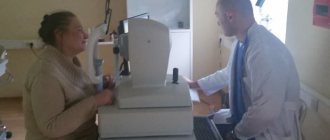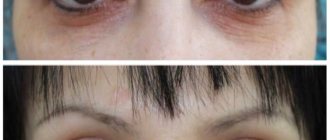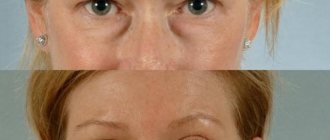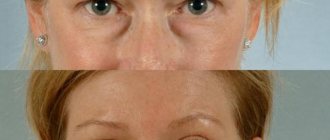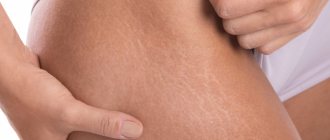Any plastic surgery is a complex procedure, and in each specific case the body may react differently to the intervention. Blepharoplasty is one of the most delicate and complex operations, since the surgeon must not only correct existing age-related changes in the eyelids, but also ensure the aesthetic appearance of the periorbital area without disturbing the aesthetic proportions of the face.
Unsuccessfully performed blepharoplasty can change the face beyond recognition, give the look a sad look, change the shape and shape of the eyes. It must be said that it is often very difficult to correct the changes that have arisen and this requires a number of reconstructive operations.
So what are the signs that indicate unsuccessful blepharoplasty:
- Noticeable scars (high on the upper eyelids and low on the lower eyelids)
- Failure to close eyelids due to deficiency of upper eyelid skin (short upper eyelids)
- Ectropion (shortening of the lower eyelid), the appearance of a strip of sclera under the iris
- Dry eyes, watery eyes
- Eversion of the lower eyelid
- Appearance of scar epicanthus at the inner corner of the upper eyelid
- Presence of residual “hernias” of the eyelids
- Deformation of the shape and size of the palpebral fissure (“round” eye)
“ROUND EYES” EFFECT
The most common mistake that an inexperienced surgeon can make when performing blepharoplasty is to excise too much skin of the lower eyelid. As a result, the so-called “round eye effect” occurs: the eyes look unnaturally bulging, and in the worst case, they do not even close completely. Needless to say, such an effect not only completely spoils the impression of the operation, but also significantly complicates the patient’s life.
Such patients develop watery eyes, dryness and redness of the eyes, and conjunctivitis often occurs. The eyes have an unnatural, “operated” appearance.
How does healing proceed after blepharoplasty?
Patients who decide to improve their appearance and refresh their eyes with the help of blepharoplasty are always interested in the rehabilitation process and its duration.
This question is one of the main ones for potential patients who are still just thinking about the possibility of surgery. Related questions also arise. How soon will it be possible to go back to work? Will the scars be noticeable? When can you wear contact lenses? What means can you use to quickly get rid of swelling? How long will it take for final healing? In this article, we will describe in detail how rehabilitation proceeds after blepharoplasty of the upper eyelids and transconjunctival plastic surgery of the lower eyelids, and we will give answers to your questions. And in conclusion, we will offer tips that will help speed up rehabilitation after blepharoplasty.
How long is the standard rehabilitation period?
Blepharoplasty is a relatively simple and low-traumatic operation. The risk of complications is minimal, they practically do not happen. The standard rehabilitation period is only 14-16 days. For many patients who strictly follow the plastic surgeon’s recommendations, the postoperative rehabilitation period is reduced to 10 days.
The healing process after blepharoplasty is somewhat prolonged due to the following factors:
- patient age over 45 years;
- there is a tendency to edema;
- the skin is thick;
- there are individual characteristics of the skin in the eye area that prolong the rehabilitation process;
- the patient smokes.
After upper blepharoplasty and transconjunctival lower eyelid surgery, a hospital stay is not required. The patient can go home immediately. Relatives are advised to meet him in a private car or take a taxi, since the eyes are not fully open immediately after the operation and the gaze may become blurred.
Painful sensations after this operation are either absent or insignificant and can be easily relieved with painkillers prescribed by the doctor.
Natural consequences of blepharoplasty during the healing period
During postoperative rehabilitation, the patient may experience:
- moderate swelling;
- small bruises localized under the lower eyelids;
- feeling of heaviness of eyelids;
- increased lacrimation;
- dry eyes;
- soreness;
- blurred vision;
- diplopia (double vision).
We emphasize that the patient does not always experience all these side effects. Usually only a few symptoms from the lists appear.
These side effects of blepharoplasty usually go away within 7-10 days. Residual swelling can persist for up to two months, depending on the individual tissue response to the new location. Proper skin care, which we will discuss below, helps to quickly solve the problem of residual edema.
Will there be scars after blepharoplasty?
This is probably the most common question that plastic surgeon patients ask. There is no need to worry about scarring, since the surgeon makes incisions in natural folds of the skin. There is a stereotype that the seams are less noticeable if blepharoplasty is done using a laser. But that's not true. When using a laser, the edge of the wound is burned, which makes the scar more noticeable than when using a super-sharp scalpel. In general, the quality of the postoperative scar depends on the skill of the plastic surgeon and the individual characteristics of the patient’s skin.
Rehabilitation calendar
1 day. You can go home immediately after the operation. It is recommended to apply cold to the eyelids to reduce swelling. It is worth taking a painkiller. 2-3 days. You can take a shower and even wash your hair (be careful not to get shampoo in your eyes). Use antiseptic drops prescribed by your doctor and do recommended eye exercises. You can read a little, but in moderation so as not to overload your eyes. 3-5 days. Visit a clinic to have your stitches removed (if they are not self-dissolving). You can wear contact lenses. Day 6 All antiseptic stickers (plasters) are removed from the eyelids. Day 7 Most patients experience bruising and swelling. As a rule, the patient returns to normal life and goes to work. Day 10 Traces of hemorrhage are reduced to a minimum. If there are no complications, you can use decorative cosmetics (it is advisable to choose products for sensitive eyes). Day 14 You can gradually resume your usual physical activities. 45-60 days. Residual edema disappears completely. Post-operative scars become completely invisible even without decorative cosmetics. The effect of eyelid surgery becomes clearly visible.
What is prohibited and what is not recommended to do during the rehabilitation period?
To ensure healing is as successful as possible, follow these simple recommendations:
- do not drink alcohol or smoke (strictly prohibited);
- do not eat salty, sour, spicy foods during the rehabilitation period;
- protect your eyes from sunlight and wind for six months (this can be done with glasses);
- after the operation, get plenty of rest and avoid physical exertion, especially those that increase intraocular pressure (lifting heavy objects, bending over);
- refrain from intense exercise for a month;
- for several days, try not to watch TV, use a computer or read (this causes dry eyes);
- try not to cry or blink frequently;
- do not sleep with your head down;
- Do not take too hot a bath or go to the sauna.
How to reduce swelling after blepharoplasty?
To ensure that swelling goes away as quickly as possible after surgery, follow these recommendations for caring for the skin around the eyes:
- I need to remove the special tape applied to ensure the correct placement of the tissues;
- regularly use medications prescribed by your doctor (ointment, eye drops);
- apply cold compresses to the eye area;
- sleep with your head elevated;
- drink more water;
- Perform the exercises recommended by your doctor to restore muscle activity in the eye area, eliminate lymph congestion and improve blood circulation.
To quickly relieve residual swelling, 7-14 days after surgery you can sign up at a cosmetology clinic for lymphatic drainage massage, moisturizing treatments and lifting. Botox to smooth out facial wrinkles can be done 1.5-2 months after eyelid surgery.
The information on the site was personally verified by plastic surgeon Maxim Aleksandrovich Osin; if you have any additional questions, call the phone number listed on the site.
REPEATED BLEPHAROPLASTY
However, there is no need to panic in any of these cases. If you have undergone blepharoplasty and it was unsuccessful, in any modern clinic you will be offered a repeat operation. Repeated intervention will help correct inaccuracies made during the initial procedure and provide the result that you originally expected.
The only difficulty is to find a specialist whom you really trust. Because after an unsuccessful operation, patients are usually afraid of repeated failure. Collect information about different clinics, look at reviews of the work of the most famous surgeons, talk with friends who have undergone plastic surgery and are satisfied with the result.
On the website in the appropriate section you can find real patient stories with attached photographs before and after the procedure. And, of course, the surgeon himself will help to fully clarify the situation during an individual consultation.
Reasons for appearance
As a rule, there are three groups of reasons that cause complications after blepharoplasty of the upper or lower eyelids:
- medical errors,
- ignoring doctor's orders in the postoperative period,
- individual factors.
The two groups are based on human factors. A surgeon’s mistake can happen if the patient entrusts his health to an inexperienced or even unqualified doctor. If the patient himself is not determined to follow the recommendations of his doctor and properly care for the skin of the eyelids after the intervention, then the result of the operation may be far from desired.
Individual factors that cause complications after eyelid blepharoplasty are, for example, an increased tendency to form scar tissue, allergic reactions, abnormal location of the vascular network under the eyes, etc. Most of these factors are excluded at the stage of consultation with a surgeon and a full examination, without which it is impossible to obtain admission to surgery.
Laser blepharoplasty: young eyes should look wrinkle-free!
Contrary to popular myths, it is impossible to eliminate crow's feet using classic blepharoplasty.
For radical eye rejuvenation, we at Platinental combine surgery with light fractional laser eyelid peeling. Carbon dioxide laser allows you to make the skin more elastic after surgery, erase the relief of fine wrinkles and improve its color, especially for those who suffer from dark circles under the eyes.
Resurfacing is performed in the clinic simultaneously with the operation under TIVA anesthesia, so pain is excluded.
Late complications after eyelid surgery
Some problems after surgery may appear after the rehabilitation period is over:
These include:
- Visible asymmetry of the eyes (appears due to uneven stitches or improper scarring)
- Dehiscence of seams (if not corrected, a rough scar will form)
- Dry keraconjunctivitis (eliminates with special drug treatment)
- The effect of “weathering of the eyes” (this is when the eyelids do not close completely)
- Tearing (caused by improper scarring or edema)
- Blepharoptosis
Most of the undesirable consequences listed above are extremely rare . And can be eliminated by repeated surgery. To minimize the risk, it is important to find a plastic surgeon with extensive experience, carefully consider the process of preparing for surgery and follow the doctor’s recommendations during rehabilitation .
Removing stitches
On what day are stitches removed?
Sutures are removed 3–7 days after surgery. A patch is applied in their place for 3 days, and after 4 days everything is removed. The skin then heals on its own and is treated with special ointments or gels to speed up the healing of the sutures.
If the surgeon used self-absorbing sutures, they will not need to be removed. Such threads disappear on their own.
Is it painful to remove stitches after blepharoplasty?
According to patient reviews, the removal procedure is tolerable. If the person wishes, the area will be lubricated with an anesthetic before the threads are removed.
You cannot remove it yourself, pull out the stitches or massage the eyelids before removal.
After the threads are removed, scars form. The skin will be sensitive for approximately 7 days after removal. Soreness is a normal reaction of the body to the removal of a foreign object.
If necessary, the doctor will prescribe painkillers if the pain is unbearable.
Usually, suture removal is painless. Only some time after the procedure may the skin in the injured area be slightly pulled.
Outline of the incisions and where the sutures are located after surgery
They form in different places, depending on the type of surgical intervention. In traditional lower eyelid surgery, the outline of the incisions is made slightly below the ciliary edge; in upper blepharoplasty, the contour of the incisions is made at the site where the skin tissue attaches to the levator palpebral muscle.
If the cosmetic procedure is circular, then the incisions are made simultaneously on the lower and upper eyelids. Incisions are made in as inconspicuous places as possible. There will also be two seams. They are performed with intradermal stitches.
The outline of the incisions is made along the natural folds of the skin. The sutures after surgery are placed intradermally. Cosmetic stitches heal and leave a thin scar, which becomes invisible by the end of the 3-month rehabilitation period.
There are no scars with the transconjunctival procedure. This operation is performed through an internal incision in the conjunctiva, so the consequences of the procedure are invisible.
During laser treatment, incisions are not made on the upper and lower eyelids. Areas requiring correction are targeted to a laser beam. The treated areas heal quickly and new tissue appears. The cells continue to renew for a month, but a positive result becomes noticeable after 7 days.
We recommend reading: How to relieve swelling after blepharoplasty
Blepharoplasty of the eyelids called “sangapuri” involves the removal of the epicanthus in the inner corner of the eye. Excess fat tissue is removed. A similar procedure is performed on Asian women. There are sutures, they are created along the muscle aponeuroses. As a result, it is not visible, creating the appearance of a double fold.
Other consequences
Complications after lower eyelid blepharoplasty include, for example, ectropion - inversion of the lower eyelid. The reason is the removal of too much tissue. Over time, an unpleasant cosmetic defect can even develop into an ophthalmological disease. Fortunately, ectropion can be eliminated either with medical therapy or surgery.
Another unpleasant consequence is the introduction of infection into the wound and the development of inflammation. Successfully treated with antibiotics. After transconjunctival blepharoplasty, a complication may be increased lacrimation, which does not stop even after the swelling subsides - this may be due to movement or scarring of the tear ducts.
Properly performed blepharoplasty does not entail risks.
With circular blepharoplasty, complications can be, as with any other type of correction, delayed, that is, they can appear later. For example, violation of eyelid closure, drooping of the upper eyelid, cyst, etc.
